An Interview with the Artist
SunStorm/Fine Art Publisher Jamie Ellin Forbes & Editor Victor Bennett Forbes had an opportunity to speak with Michael Cartellone over the summer. Here is a transcript of their conversation.
JEF: Hello, Michael. How are you doing?
MC: I’m doing fine. It’s nice to hear your voice.
JEF: Oh, exactly what I was thinking. And how’s your lovely wife?
MC: She is wonderful. Thank you for asking.
JEF: Excellent – you’re both doing well and happy.
MC: Yes, life is good.
VBF: Michael, bring us up to date on your most recent paintings.
MC: I just finished a painting that I spent a full year working on. It’s Beatles-themed, large in size and photo-realistic in detail capturing the legendary concert that they did toward the end of their career, where they went up on the rooftop of their building and you could see the skyline of London in the background. That’s a very well known subject because they literally made a concert film up on the roof. What I did with my painting was something that hasn’t often been seen. I had the vantage point of the painting
from sitting behind Ringo’s drums looking out. Seeing the three Beatles from behind in front of him, and then the skyline in the distance so literally you the viewer are Ringo.
JEF: Oh, that’s amazing.
MC: Thank you. I actually came up with this idea 15 years ago and as I have a tendency to do, I come up with more ideas than I can actually physically paint, so I just write them down and when I finish a painting, I look through the list and see what the muse inspires me to do. Well, it took 15 years, but I finally got around to this one and could not be happier with it. The painting is called “Ringo,” because, of course, it’s about him.
JEF: That’s a great discipline. It sounds like that’s the way you discipline the center of your playing.
MC: I’ve always been someone that really enjoyed the detail of everything even as a little kid when I started playing drums. I just loved just diving head-first into everything. That never changed with the drumming and has always been with the painting. I did detailed things in this painting that some people would never even see, but I did it because I knew they needed to be there. This is something as specific as the brick and mortar pattern on the building across the street from them. This is the kind of stuff I
Fine Art Magazine • Fall 2023 • 5
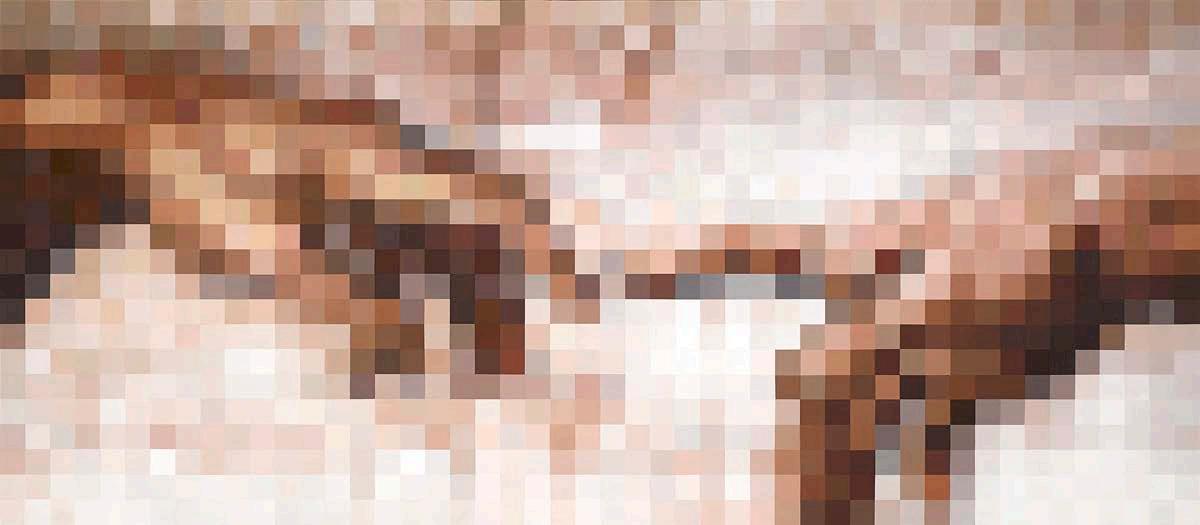
“CoA2”
studied from photographs and concert footage to really make it as true to life as it can be.
JEF: That’s quite a mindset.
MC: It was fun. I knew that I was kind of creating a mountain to climb because of the amount of detail that I wanted to achieve and the size of the canvas itself. But that was okay. There was no hurry and I had it taped up to a sheet of plywood here in my room where I paint and that’s where it sat for a year, and it slowly came to fruition.
JEF: That’s, that really is incredible. What size is it?
MC: It’s three feet by five feet.
JEF: Is it all set to be displayed at your next exhibition?
MC: It’s going to be at a Wentworth Gallery at the Hard Rock Hotel Casino in Hollywood, Florida. Lynyrd Skynyrd is kicking off its 50th anniversary tour right in that same area. So we have kind of coordinated it so that this painting is going to be unveiled at the same time as we kick off this big tour.
JEF: That should quite create quite a stir.
MC: I hope so.
Skynyrd record has classics, but that record that has “Freebird,” “Simple Man,” “Gimme Three Steps.” That’s pretty strong. We’re talking about songs that are part of American pop culture. I mean “Freebird” is so iconic and to be fortunate enough to get to play that song every night as my wonderful ‘night job’ lets me do, is great.
JEF: How are you inspired when you paint, using a different means of expression than music? I would imagine at 18 you’d have to be pretty inspired, like somehow the Muses have to be coming through and talking to you specifically.

Manager Brian Epstein watching them perform with Ringo visible to his left
MC: Well, sure. I can’t speak to what they were inspired by 50 years ago as they were writing these songs, what I can say, Jamie, is that I started playing drums when I was nine. I played my first bar when I was 11. So if it is what someone is meant to do. the inspiration is always going to be there. People have different ways they tap into it. Some people rise to greater heights and Ronnie Van Zant and the guys in the original band on that first record certainly did that.
JEF: What other work will be in that show?
MC: There will be a painting that I’m actually just getting ready to start that will be a tribute to the original seven members of Leonard Skynyrd 50 years ago when they released their first album.
VBF: Of course that’s “Pronounced”, which Ronnie calls his masterpiece.
MC: It’s really is just an astounding, beautiful work. Those songs on that record — their debut (major label) album — it’s just really kind of mind boggling what they came up with. Every
JEF: You hit the nail on the head, you hit the center. People get inspired and then they express themselves and absolutely keep focused. I think that’s how art is manifested, how art flows from people. I think every now and then, it sounds like you hit the universal. You’ve hit a lot of key elements that people speak the language of — Ringo, the Beatles, 50 years of Lynyrd Skynyrd. It’s also a retrospective your work. So I think it resonates. Now is a great time for things to resonate with people because I think people need to reconnect and feel inspired again.
MC: Yes, I agree and thank you for that compliment. I’ve been fortunate that the ideas that I’ve come up with to paint do strike a chord with people. I never know where those moments of
6 • Fine Art Magazine • Fall 2023
Beatles
– The title represents The Creation of Adam, squared

inspiration are going to come from. Sometimes they just drop out of the sky <laugh>.
JEF: Oh, sure. I can understand that.
MC: And I think that’s what makes them artistically special or creative or inspired.
JEF: What that impression is people have, if you have to get that impression out, you’ll express it, and then it floats out on sound or flows out in a painting, whatever it is. It begins to almost direct itself at some level. I’ve seen you at work and I know how disciplined you are. I’ve been to your studio. I know how your work manifests, how it flows and I think it pretty much connects fluidly with the subject matter, the timing and everything.
MC: Thank you. You know, this is a vantage point that I spend a lot of time in so I don’t know if just one night while I was sitting behind the drums that this idea popped into my head. It may have. I have painted the vantage point from behind the drums, from my own drums. I’ve painted that before. But to paint someone else’s vantage point using the same location, that was a fun idea to develop.
JEF: It’s a nice progression from the last two series of works that we’re familiar with—the Davids and the Pixelated—and now the two big portraits. How do you see these as a collected body of work?
MC: They’re connected just simply because the same artist is doing them. And, you know, my touch, my hand, my style is going
to flow through, even if the subject matter is vastly different. But I feel that because the paintings truly are a reflection of things that are important to me, then I truly am a part of every one of those works, which then ties them all together.
JEF: Absolutely. That’s brilliant. Will you just show at one gallery during your tour or you will be sharing through other venues?
MC: Wentworth has eight galleries right now and their routine is that they always are circulating the work throughout the entire chain. In addition to the original painting, there will be the limited editions so at any given time, people will be able to see it in various cities. That’s one of the nice things that Wentworth has done. Even if I’m not doing an actual in-person show, people can walk into any Wentworth Gallery and see a collection of my things at any given time.
JEF: Wentworth has lovely galleries. I have to say, always a nice display. I’ve been in and out of them. They do a great job.
MC: They really do. I’ve been working with them for 12 years now, and they’ve done really, really well for me. They also work with several other musicians so they have this machine very well oiled.
JEF: Do you remember when we introduced you to Wentworth founder Michael O’Mahony at the Artexpo in New York?
MC: I absolutely do. And in fact, the other day when I was speaking with Christian O’Mahony it came up about how I first met his father. He thought it was an introduction from someone from another band and I said, ‘Oh no. I’ll tell you how it happened’
Fine Art Magazine • Fall 2023 • 7
The pure joy is evident in this screen grab of MC enjoying the guitar virtuosity of Hughie ThomassonLynyrd Skynyrd - I KNOW A LITTLE - live Saarbrücken 2003 - Underground Live TV recording
and I told him the story of Artexpo at the Javits.
JEF: I remember Victor and I walking with you down one of the aisles to meet Michael. He was an advertiser in our magazine.
MC: That’s right.
JEF: It all started with that John Lennon portrait the Grant Gallery. They sent us a press release which we published in Fine Art. I’m glad you benefited from that. That’s just wonderful.
MC: You guys know, of course, that Michael passed away a few years ago.
JEF: I wasn’t aware of that, but thank you for telling us.
VBF: He was something else again. Staunch defender and supporter of his artists. Probably last of the old school. You had to be good to be in his circle. You see that cover with Michael and the Globe? (Ed. note: see Page 34). That was in a 1993 Fine Art magazine edition at the height of the Artexpo years. It was an honor to do business with him. We had a lot of interactions with him over the years with all his artists and our friend Ken Keeley of those famous newsstand paintings, put that cover on the stands with Vogue, Look, Life and all the magazines of the day. When did you join Skynyrd?
MC: 1998,
VBF: Oh my goodness. So you got to play with the great Hughey Thomason. I read where Ronnie told him Green Grass and High Tide was their “Bird.” And of course that song title comes from the classic Rolling Stones album of the same name. When Ronnie saw the Stones in Jacksonville it changed his life, inspiring him.
MC: I should also mention I worked with Leon Wilkeson and Billy Powell for 10 years.
to be and I do think that that work component, when people focus and dedicate and work towards something special, after a while, it’s like a little steam engine. It just keeps ripping along, you know?
MC: Sure. Absolutely.
JEF: It produces an alchemy of change. That’s how I see it. I’m a student of how things happen by degree. I think anyone that applies themselves in whatever walk of life or career they’ve chosen, all of the same rules apply,
VBF: Getting back to your painting of the original group, do you think you could throw Al Kooper in that painting?
MC: <Laugh>? I’m sure Al would like me to do that, but with all respect, ‘No.’ It’s just gonna be just the guys.
VBF: Without him, I don’t know what would’ve been.
MC: Well, you know, he produced that first record. That’s him playing organ on “Freebird.”
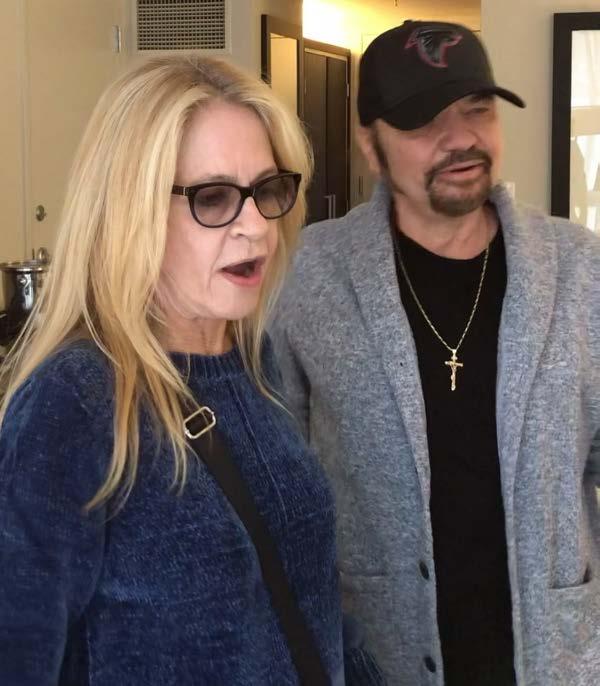
Surprise! Dale & Gary view the portrait for first time.
VBF: I can only imagine what that must have been like.
MC: It’s been wonderful. I think we’ve discussed this before, but you know when I was just a kid playing in bar bands in Cleveland, Ohio, where I’m from, of course I was playing Skynyrd tunes.
JEF: Really?
MC: So, you know, this is not lost on me at all. I know how fortunate I’ve been and how cool that this is what I get to do.
JEF: You’ve always said that, Michael, you’ve always been very humble. You’ve always said how fortunate and lucky in that regard. But I know you worked very hard.
MC: Well, I did, Jamie, I did. But, but at the same time, you know, I was raised in a blue collar family and consider myself a working musician. I happen to be in a well-known band, but, I’m just a working guy, that’s all.
VBF: Just as Ronnie sang – “But I keep on workin’ like the workin’ man do…”
JEF: I have a feeling in life people arrive at who they’re supposed
VBF: And mellotron on“Tuesday’s Gone”. He put the horns on “Mr. Breeze” and the ladies on “Sweet Home Alabama.” A neighborhood guy from Queens, of all places.
MC: Did you know that although I’ve never met Al, he and I are on a record together, which is not that unusual in that you end up recording something and then you find out that someone else ended up adding their part to it another time.
VBF: Which one was that?
MC: There was a German heavy metal band called ACCEPT. I did a couple of records and tours with them in the nineties. It was a few years prior to joining Skynyrd. The guitar player from that band had put together a solo album where he took all these great old orchestral pieces and did a kind of heavy metal guitar instrumental version. It turned out that Al Kooper ended up playing Hammond B3 on one of the songs.
VBF: He played with everybody. I’d love to see a painting of Ronnie talking to Al in the Bentley after he walked him out of the studio when Al told him he was not crazy about Simple Man.
MC: <Laugh>. I would not paint that.
VBF: Let’s talk about the Rossington portrait. Is the original going to go on tour?
MC: No. Gary and Dale, own that painting. Wentworth published the limited edition prints. That was a really fun painting to do and Gary and Dale had no idea I was doing it. They, like myself, are huge van Gogh fans and I thought, ‘You know what? I’m gonna paint Gary and make it look like a van Gogh painting.’ So I used “Starry Night” as the reference and I just put all the swirls into it. I painted that one at home and when it was done, I brought it out on tour with me because the band had just a quickie weekend of shows. I set it up in my hotel room on an easel and I threw a sheet over it. Then I called Gary and said, ‘Hey, could you and
8 • Fine Art Magazine • Fall 2023
Dale come down to my room? I have something really important I have to talk with you guys about.’ I made it sound way more serious than it was and they came to my room, looked around and saw this sheet covering an easel. I didn’t say a word, just yanked the sheet off and it was an incredible moment. I have video of it.
VBF: Could you talk a little bit about your relationship with Gary? I mean, it’s many years you’ve known this man.
MC: 26 years. Gary was just an incredibly kind, humble person and he was quiet, but very wise. A man of few words. But when he would speak, you would stop and listen because it was going to be worthwhile to hear what he had to say. He was really fun to be around. Not only did we share a love of van Gogh, but Gary is also a Beatle fanatic. Most of our conversations in the years I had the pleasure to work with him were about The Beatles. It was a never-ending subject. There was always something we could talk about that would be related to them.
JEF: For example?
MC: At one point we had done an international tour and on this particular tour we were in Liverpool, England. Gary arranged for the entire band to be taken on a private guided tour around Liverpool to all the Beatles spots. So it was a really generous thing that Gary did for us and of course, the entire time he and I just were chatting. I mean we could not stop. We were just giddy with excitement. There were a lot of things—a lot of information about things—that we were seeing that I had already studied that Gary was not aware of. So it was fun because he was constantly asking, “Tell me exactly what this is.” It was just really a very cool friendship.
VBF: Did you by any chance talk about the days at the Cavern when they all thought they were going to be Gene Vincent and Eddie Cochran?
MC: We went to it. However, The Cavern in the early nineties, if memory serves, was closed and they were going to use that area for an underground transportation station an underground train of some sort but they had started to fill in The Cavern. It’s just unbelievable that they actually did this. The outcry was so huge that they realized they can’t do that. It took a few years, but they finally dug it back out. They excavated, but because of what had changed with them filling it in, when they rebuilt it was turned a slightly different way. So when we went down there we took a band photo on the Cavern stage, and I had to tell Gary, ‘You know, this isn’t actually where the stage was. The building was turned this way, and the stage was over on the other side of what’s now a wall.’ But it was still amazing to be there. No question about it.
VBF: I heard a Mike Bloomfield interview and he said he was such a big Beatles he wanted to know everything about them—what they had for breakfast, what the kind of cereal they ate. He wanted to know every little intimate detail about those guys. You wouldn’t think Mike Bloomfield, such a great blues guitar player, would love The Beatles so much.
MC: Yeah. Very entertaining.
VBF: I read where Ronnie was enamored of the Stones especially. MC: Those guys grew up in a wonderful time with amazing music to be inspired by.
VBF: And then you come along, playing drums. Besides the physicality of it, the art form that started even with Bob Burns was integral to their sound. He was a rare, a rare drummer because he was so sensitive and everything mattered. You could really hear it, you know, the hard hits and then a smooth cymbal crescendo. How did you manage to pick up all these subtleties from him and Artemis and incorporate them into the act where everybody, like
thousands, hundreds of thousands of people knew every note that was ever played by this band. And you come right in there and for 26 years, you’re holding it all together.
MC: Well I’m a detail guy. <Laugh>. Exactly. Bring on the detail. And you know, again, Victor, these are songs that I was playing when I was 13 years old. So I didn’t have to learn how to play “Freebird” when I joined the band.
VBF: To be up there with Gary and Hughey and Ricky, and Leon and Billy for those years you had with those original members
— wow.
MC: To play these songs with friends in high school, you know, when I was 13, and then play them with Gary Rossington. Two very different things. <Laugh>
VBF: And all the while you managed to keep this art career going strong. It’s a strong career.
MC: Thank you. You know, the painting preceded the drumming. I was painting when I was four and then started drumming when I was nine. The art was my first love and what I thought was going to be my life’s work. Somehow I’ve been able to, a little bit later in life, bring the art as a second career to the forefront, which has been wonderful,
VBF: Very wonderful, for the public, for yourself. Watching the band play and on videos and in person and everything else it’s not just music. It’s like in a way, it’s a spiritual event, especially when Gary was still there. It must have been something else when the other original guys were still on stage with you.
MC: It was, it’s all been wonderful. I’ve been very fortunate to play in this band with a lot of incredible musicians from day one to day now.
VBF: When you made that portrait of John Lennon, could you have imagined being at the Cavern with Gary Rossington talking about the Beatles
MC: If memory serves I did the Lennon painting after the Cavern. I should mention I also did a Pixel of John Lennon.
VBF: How are people responding to those pixel works? That’s a very unique method of painting.
MC: Thank you. People have responded very nicely, very supportively. There are now 19 of those paintings. They take time. But it’s really been fun building that body of work. The “Ringo” painting was taking a slight pause from doing the pixels which are very demanding on my eyes. Painting all those squares, standing away from the canvas and squinting so I could see the colors mix, which is the technique that I do for that…it’s tiring on my eyes. I got to a place where I thought, ‘You know what? I need to take a little break.’ And then I did the exact opposite of painting squares and I did photorealism. <Laugh>.
VBF: It’s a very lovely body of work, and I can only imagine it’s going to get lovelier and lovelier as time goes by.
MC: Thank you.
VBF: This 50th anniversary tour, do you think this is gonna be the end of the line for this aggregation?
MC: I don’t believe it is going to be the end. Gary, God bless him may he rest in peace wanted this music to continue on and even when his health started to become a problem and a concern for him traveling with us, he wanted us to keep playing. He would come out just every now and then when he felt up to it. We worked a fair amount in 2021 and 2022 without Gary, because he wasn’t physically able. Dale also wanted us to keep this music alive in his honor and for everyone from the original band—we’re paying tribute to all of them every night that we play. I kind of feel when
Fine Art Magazine • Fall 2023 • 9
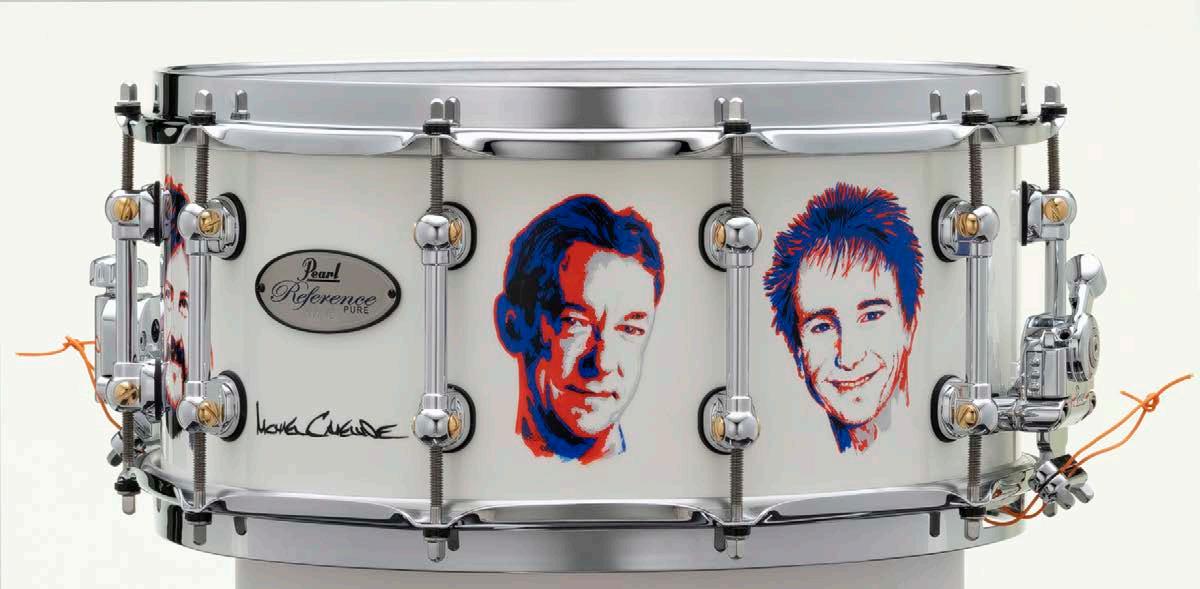
the people that follow this band, if they don’t want to hear us, they’ll tell us. But if they want to continue to hear this music, we’re gonna happily keep delivering it to them.
VBF: Gary, I know, really enjoyed keeping the memory of his friends alive.
MC: Not only that, but Ronnie Van Zant, I think, would love knowing that all these years later his songs still are as important to people as when he wrote them.
VBF: That’s a fact. Were you ever in the studio with them on the latter recordings over the years, Last of the Rebels and such and such?
MC: Yes.
VBF: So you’re privy to the songwriting elements of how things went in the studio. I always wondered how they figured out those intricate guitar parts when there were the three of them.
MC: That’s just the way this band was structured. It’s very focused and it’s very unified. So when they’re writing those guitar parts, which as you’ve just said, are very intricate, and you know, I’m not a guitar player, but I certainly admire what they’ve done, crafting these guitar parts, because I will tell you, I’ve walked into a bar band playing in any town USA and hearing a band cover a Skynyrd tune, you really can tell if the musicians have done their homework or not. These songs are deceivingly difficult at times to play.
VBF: Absolutely. Each and every one of them and the way that Gary worked with worked with Alan and then Ed and then Steve, it was just really so artistic and brutally so—it grabbed you by the throat. It was like, how would you, if you were a painter, how would you describe such music?
MC: What’s interesting is that for the most of the band’s career, there were three guitar players. There was one short period of time where there were only two. But what they’ve done, and I admire this, is they’ve had three very unique stylistically different guitarists complementing each other. What those three guitars do are different from each other, but they kind of co-mingle and create a combined force to be reckoned with.
VBF: And the drum parts that went with them, it seemed like every drum beat was like a brushstroke in a painting. The way you play it, you’re so sensitive to what they’re doing. It’s a beautiful
artistic statement when viewed in that way.
MC: Truly. The rest of the instrumentation is informed by that— creating the song, blazing the trail. Your job as the drummer, as the piano player, as the bass player, your job is to take what they’ve given you and have that inspire you to further enhance what’s already been created
VBF: And kick some butt while you’re at it.
MC: Ideally <laugh>,
VBF: I see you behind the drums that beating them.
MC: It’s a wonderful career.
VBF: I learned so much from watching those guys play and reading about their early days forming a band and the great joy of communicating musically with people of a like mind and the power that gives you when it is firing on all cylinders. You feel invincible. Another thing that I love about your work is that portrait you made of Ronnie. Cause I think the to me, and this is my thesis, and I’ll probably get shot for this by a million people, but I think one of the best blues songs ever written is “The Ballad of Curtis Lowe.”
MC: That’s a great one.
VBF: Because he talks about the black man’s blues, that when Curtis he lived a lifetime playin’ the black man’s blues… “on the day he lost his life that’s all he had to lose.” He had nothing left.
And that’s what the blues is, really.
MC: We’re going to be doing that song this summer.
VBF: Takes a lot of heart to do that.
MC: Yeah, that’s a good one.
VBF: Kooper played on that. He played piano.
MC: Really?
VBF: If you listen to it really closely, and you really have to listen to the very end of the song, he does a triplet, the last note on that classic cut. There’s a classic story Allen Walden, their manager, related about the infamous contract from MCA when Walden puts the puts the pages of the deal on the hood of the engine of his truck and Ronnie, after reading it, says to him ‘What do you think of this?’ And Walden says, ‘This is the worst piece of garbage I ever
10 • Fine Art Magazine • Fall 2023
Hand painted drum of Michael’s Drumming Heroes to commemorate his 30th Anniversary as a Pearl Drums endorser
 by Doltyn Snedden
by Doltyn Snedden
saw.” Ronnie’s classic response: ‘What else we got?’ and Walden simply replied, ‘There’s nothing.’ So he signed it and Kooper had himself a band and over the next two years produced three of the best albums in recorded history (“Pronounced”, “Second Helping” and “Nuthin’ Fancy.”
MC: Yeah, that’s right. It was Kooper’s label, Songs of the South that MCA funded.
VBF: That’s where the ferocious song “Working For MCA” came from. Ronnie practically growls his way through it. Kooper met the band at “Atlanta’s Original House of Rock”—Funochio’s—on Peachtree Street recorded them at the Atlanta Rhythm Section’s studio, where they also recorded another classic album, “Street Survivors”—their only one with Steve Gaines. I look at Allen Collins and Steve Gaines and Ed King and Billy and Leon and all those guys and Cassie and I say, ‘It’s a tragedy, but it’s also the opposite of a tragedy because they shed so much musical light in the universe.”
MC: Truly.
VBF: And for you to be a part of it, it’s a great honor to talk to you. I feel very fortunate that you give us this time.
MC: Oh God, I’m flattered that you even have any interest, so thank you.
VBF: Well, the good thing is I had interest in your art before I listened to any Skynyrd song other than what I heard on the radio, mainly “Sweet Home Alabama: and”You Got That Right.” Until that show you invited us to a couple of years ago in Saratoga, NY. I never listened to “Freebird.” Can you imagine?
MC: No, I cannot imagine <laugh>.
VBF: So what I did was—during the pandemic—I was working on a big book project and to keep myself mentally together, I did the yoga headstand, which is supposed to be good for the writer’s brain. Every time I assumed the position, I would put on the 10 minute version of “Freebird,” the original complete one, the one

that wasn’t on “Pronounced”. Kooper cut off the Beck Bollero part because it was just too long for airplay. The whole thing is on youtube and I would do a headstand for the entire duration. Standing on your head. one really gets one to appreciate every element on that song as I’m waiting for it to end so I could come down. That’s a pretty deep way to get into Allen Collins. He played notes at a speed faster than the human mind, even in Sirasana, could comprehend. The fact he wrote that when he was 18 years of age makes it even more, could I say ‘miraculous’? The lyrics and Ronnie’s vocals, Gary’s slide part, Kooper’s churchy organ are indelibly etched in my consciousness. And then comes along Steve Gaines who matched him note for note on the live version from the Fox shows.
MC: A different type of player. They had different things that they brought to the table.
VBF: When they did Freebird together on the live album…
MC: Wonderful. Gary is a very different type of guitarist than Ed and a very different type of guitarist than Allen, but what they did uniquely and separately tied together into this amazing, kind of cohesive triple bill.
VBF: Really was special on every level.
MC: No question about it.
VBF: And for you to be up there every night experiencing that energy with Gary for all those years must have been nothing short of cosmic.
MC: Yeah. It’s a great life. No question about.
VBF: Well, you’ve accomplished a lot and it’s a blessing to be affiliated with you in this way.
MC: Well, thank you. it’ll be a great tour, no question about it.
Fine Art Magazine • Fall 2023 • 11
2011 - On tour working on the self portrait
Photo

FIFTY, original painting and limited edition print
Lynyrd Skynyrd’s debut album, “Pronounced”, was released in August 1973. As a tribute to the band members on that album and Leon Wilkeson, I decided to paint a portrait of the seven of them. I spent about two months working on the painting and consider it an honor, all these years later, to perform the music made by these amazing musicians.
— MICHAEL CARTELLONE
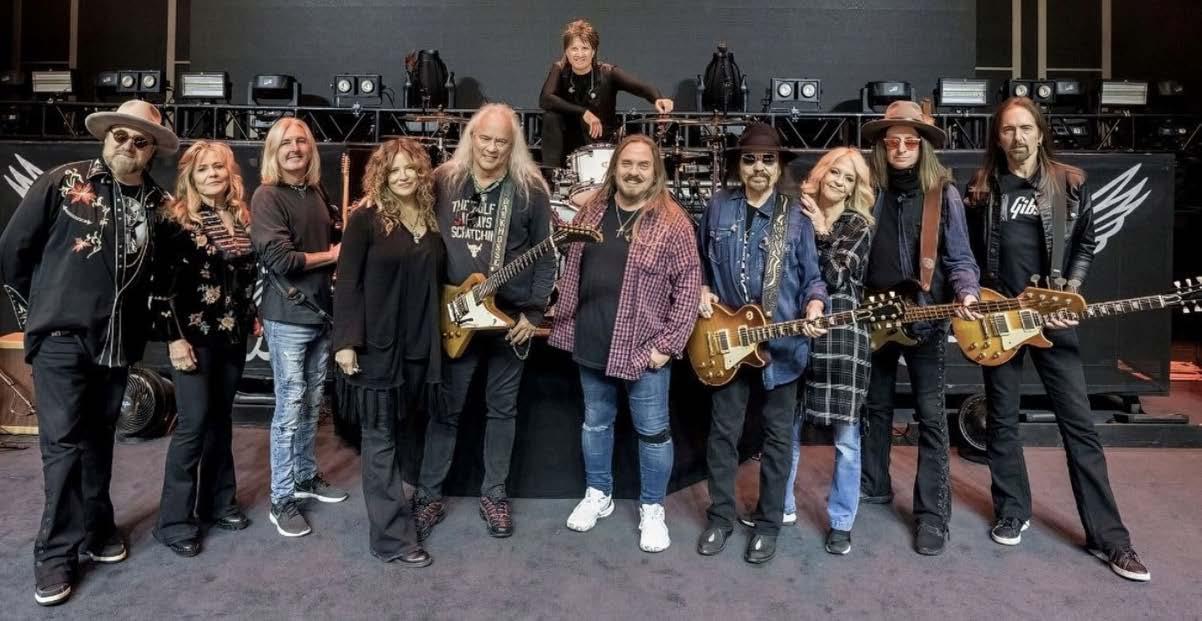
12 • Fine Art Magazine • Fall 2023
Gary’s Farewell Gig

“I’m
not throwing TVs out of the window. I’m sitting by the window, painting. . . . I realize I might be bursting some bubbles.”

Fine Art Magazine • Fall 2023 • 13

14 • Fine Art Magazine • Fall 2023 E2

All I Can Do Is Write About It – Ronnie Van Zant
Do you like to see a mountain stream a-flowin’ Do you like to see a young ’un with his dog Did you ever stop to think about, well, the air your breathin’ Well you better listen to my song
And lord I can’t make any changes, All I can do is write ’em in a song I can see the concrete slowly creepin’ Lord take me and mine before that comes
Fine Art Magazine • Fall 2023 • 15
RONNIE VAN ZANT

I miss Gary dearly. He was a great friend, both on and offstage. His guitar playing truly was the backbone of the Skynyrd sound … it was integral to me as the drummer and would guide the path of how to play these songs. Our offstage friendship was centered around our shared love of The Beatles. In my 26 years knowing him, 95% of our conversations were about the Fab Four… and we never ran out of topics!
Interestingly, I never asked Gary who his favorite Beatle was … He knew John Lennon was my favorite and he enjoyed telling me about the time he met him.
16 • Fine Art Magazine • Fall 2023
JL2

“We were at the Record Plant in Los Angeles and Al Kooper was producing us. He had a lot of friends out there. He’d done Electric Ladyland with Hendrix, played with Michael Bloomfield and Steve Stills on the Super Session album and of course played with Bob Dylan on organ on Like A Rolling Stone. He was big-time and John stopped by the studio to see him. He wasn’t with Yoko, he was with May Pang. We were playing a song when they walked into the booth. We all saw it was him and freaked out. We quit playing. Scared us. There was John Lennon. A Beatle! We got to meet him, shake his hand and then went across the street and had lunch with him. It was great.” Gary said they were so blown away by meeting him that they couldn’t concentrate while recording the rest of the day!
Fine Art Magazine • Fall 2023 • 17



20 • Fine Art Magazine • Fall 2023
Michael and father, Joseph, who is the subject of the painting behind them

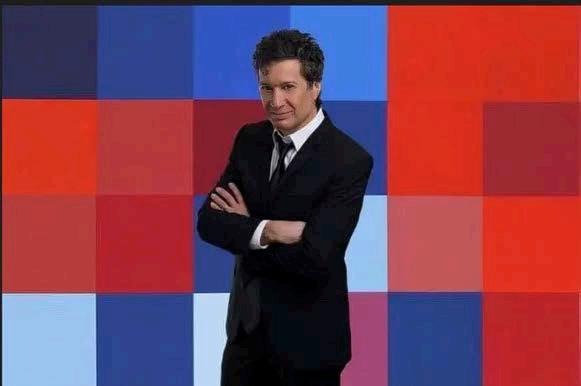
“Michael Cartellone is a creative perfectionist. Few artists have either his attention to detail or the fluidity and creativity of a master storyteller. It is no surprise that Michael worked as a professional fine artist before his great successes as a musician,” commented Christian O’Mahony, Principal, Wentworth Gallery.
When asked what inspires him to create both music and art, Cartellone remarked, “For me, music and art represent two halves of a whole…it’s a perfect circle of balance and motivation…I cannot imagine one without the other.” Cartellone’s art represents a vast array of themes and styles, with nods to art history, photo realistic portraits, music-themed works on drumheads, sprawling landscapes, and colorful pop art. Working on “David” 1965

Fine Art Magazine • Fall 2023 • 21
Michael with mother, Grace, at a Wentworth Gallery opening with David paintings in background






22 • Fine Art Magazine • Fall 2023
Lynyrd Skynyrd Live 2018 playing as usual to a packed house – Three guitarists: Gary Rossington (in blue shirt), Ricky Medlocke and Mark “Sparky” Matejka with Johnny Van Zant out front singing

Music, Art, Magic & A Century of History
By VICTOR FORBES
Reprinted from Fine Art Magazine Winter Edition, 2008
The hallmarks of Michael Cartellone’s life and career, as stated in the above headline, are separate yet indelibly intertwined. Certainly a life blessed with success, love and happiness based on years of hard work. He is regarded as one of the top rock drummers in the world keeping the beat for a band that represents survival, hope and power despite unspeakable tragedies. The Lynyrd Skynyrd catalog and spirit will live forever in the annals of music and while there is only one original member left, the spirit of the music transcends time. But somebody has to keep the beat and that somebody is Michael Cartellone.
FINE ART: Hello Michael, it’s been a while.
MICHAEL: Yes, it’s been a few years.
VF: But I want to tell you your growth as an artist over these years has been remarkable.
MC: Thank you

“1890s
New York scene with three heroes: Houdini, my dad Joseph and Charlie Chaplin.”
VF: It must be very satisfying. We know all about your other career — in the music world which is top notch —
MC: My night job.
VF: Tell us about your new work, “The Four Davids.”
MC: The Four Davids are my series of paintings about 100 years of art history. I took Michelangelo’s “David” (have you seen it? Have you been to Florence?) You know how powerful it is when you turn
the corridor and see him at the end of the hallway in the arch. It takes your breath away. I was so moved by that I thought I needed to do something in tribute; to paint this statue and it took a few years just trying to come up with how to do that. I simply could not come up with only one way to do that.
VF: So you started with van Gogh?
MC: I came up with the idea of painting him four times, and then I thought, well, if I am going to paint him four times, maybe four different style, four different art styles, maybe four eras of art, so then
24 • Fine Art Magazine • Fall 2023
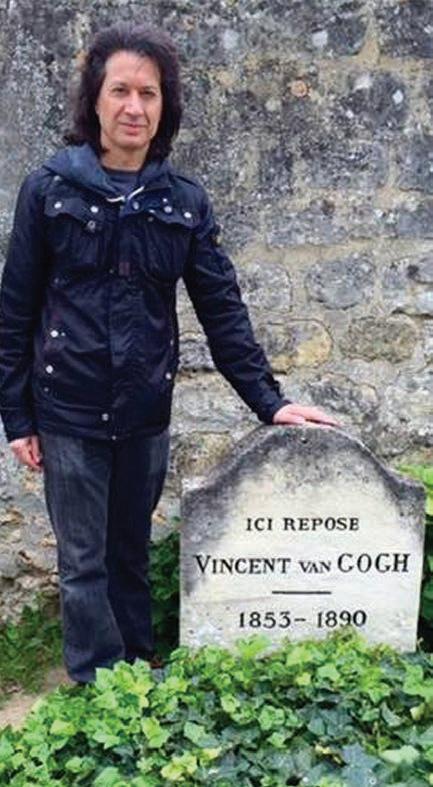
Visiting van Gogh’s gravesite
“I’m going to keep painting worldfamous recognizable statues within the context of a recognizable art style.”

I started doing some art history research in depth and created a list of about 20 different painters/eras and whittled them down to four. The four painters who were of inspiration were van Gogh, Picasso, Roy Lichtenstein, Andy Warhol. Upon looking through their body of work, I wanted to find images that they had done that I thought would be interesting to use as a starting point.
VF: And then…
MC: (For example) Let’s use the inspired van Gogh piece for starters. That was from a portrait he did in 1889, a very recognizable portrait. I have a coffee mug of that portrait on my art table in the other room. In essence, by utilizing the look of van Gogh’s self-portrait, I pulled him out of it and put David in place and painted David exactly in the way that van Gogh had painted that self-portrait. The same colors, all the swirls, the light, the shadow. Everything was matched — van Gogh’s face to now David’s face.
VF: Was it a scholarly experience or was it emotional ?
MC: Both. That painting in particular was a mountain to climb because it was so incredibly different stylistically from the way that I normally paint, which is more realism with a slight Pop colorful quality to it and none of that applies to a description of van Gogh so in essence, I had to throw everything away that I had really learned and what was instinctual to me as a painter and start over which was an incredible experience.
VF: And this is your new path?
MC: Yes, it’s been wonderful, Victor, because it has, with the Four Davids, enabled me to then paint in four styles that I never painted in before which meant I had to re-learn with each successive David
a new way to paint. Living here in New York, of course, I have access to work of all of the above. So I was going to MoMA and looking at “Starry Night” and I’m matching paint colors and getting my face right up to it and looking at the thickness,and the texture and the brushstrokes then I would come home and work on my David. The reference material was incredible. So there was a lot of thought, a lot of research throughout. Before, during and frankly since. It has now created this whole new path of art I’m going to keep doing this. I’m going to keep painting world famous recognizable statues within the context of a recognizable art style. In essence, kind of mixing the two mediums — painting and sculpture.
VF: In addition to the Four Davids, that Magritte piece is quite a production.
MC: Thank you. “The Magritte Condition” I painted directly after the Davids. That was the very next thing that I did. Renee Magritte has always been one of my favorite painters and the “Magritte Condition” utilizes many of his well-known, tried and true themes and combines them together into one painting, putting a kind of contemporary spin on it. I should mention that same contemporary spin applies to the Davids. Even though those paintings are really a double homage (a homage to Michelangelo first and then whoever the painter of inspiration is secondly). What I am intending to do with the Davids is have the viewer realize I am tipping the hat to the masters, as it were. But then with my new works taking the viewer into a new kind of place that hasn’t been seen artistically.
VF: Seems like you’re setting it up like what they used to call record albums.
Fine Art Magazine • Fall 2023 • 25
The Magritte Condition

MC: I am, yeah (laughter)
VF: Where Side One would get you involved and the last song on side one would make you want to turn it over to get to side two
MC: Exactly to keep going. Too bad they’re not albums anymore, it’s a digital chip.
VF: Vinyl’s is coming back
MC: As vinyl should Nice segue to the music business
VF: Let’s talk about this for a second. Here you are a very sensitive handsome young fellow making these paintings
MC: Handsome, young (laughter)
VF: Why not? You played with two of the hardest rockin’ bands that ever set foot on the earth. A Jekyll and Hyde thing. I can only imagine you back there behind The old Amboy Duke (Ted Nugent) and the Lynyrd Skynyrd guys. How do you balance the two in your life?
MC: Balance is truly the key. Ever since I was a child I was painting or drumming. They have coexisted in my life. Art school, and mu-
sic school throughout my youth. There always have been these two halves of the whole and it’s very difficult for me to separate them. In my mind, one could not exist without the other. They feed off each, they enhance each other, they motivate each other and balance each other. The night job — the drumming — is loud and public and in front of a lot of people and the painting is quiet, personal, introspective. So that, in essence, does give me the balance and I carry painting supplies during the tour and paint in hotel rooms during the day and then play that night. So it truly is a beautiful balance. Could you tell us about your interest in Houdini and Charlie Chaplin and your collection of their artifacts?
MC: Sure. Chaplin and Houdini both are lifelong fascinations of mine. I was a magician when I was a little kid and I saw a Chaplin film in a film history class when I was young and maybe I was born in the wrong era. I think I was supposed to be from the Golden 20s and maybe I was, maybe I came back. There has always been mag-
26 • Fine Art Magazine • Fall 2023
Sweet Home … Yonkers. Michael and his wife, Nancy.
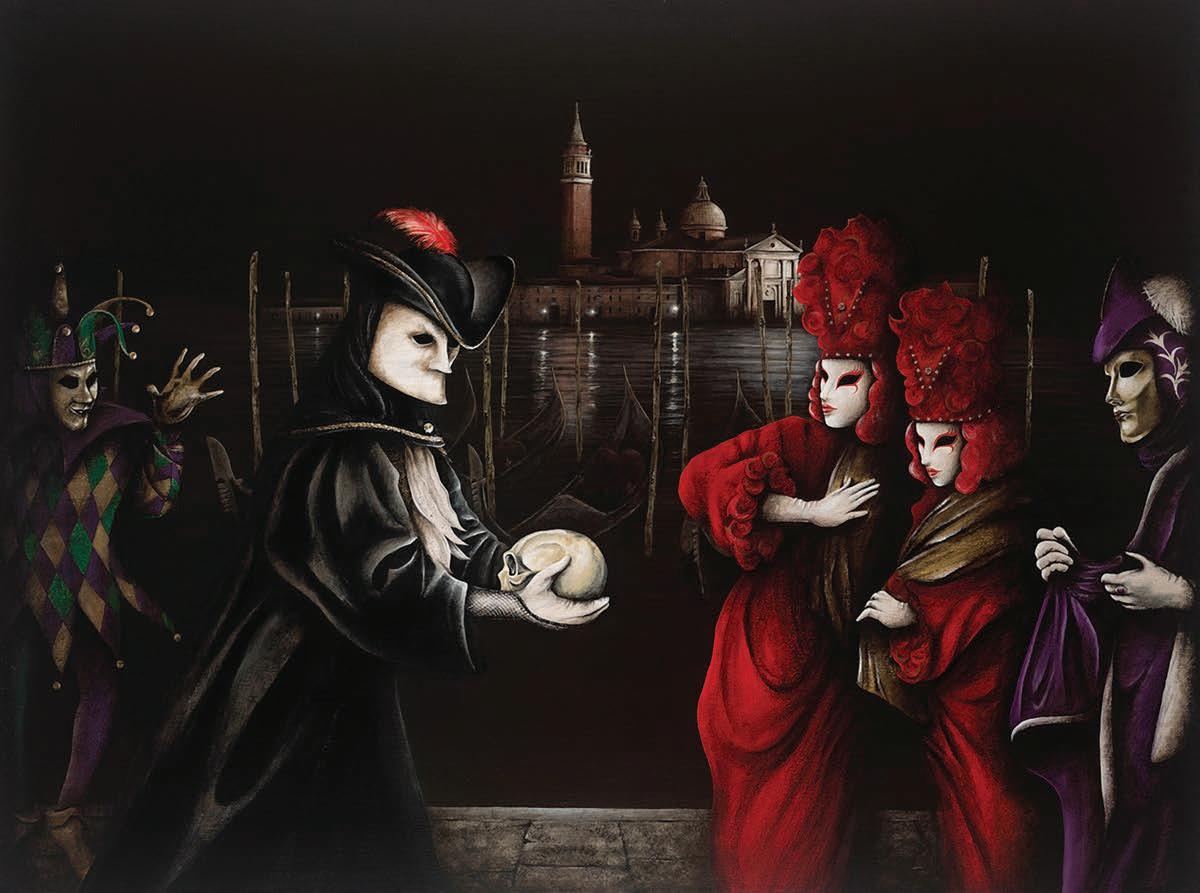
ical thing about the twenties for me. So much so that the painting “New York” It is a 1920s era New York City street scene. In this painting I put my three heroes — my father, Houdini and Chaplin. I have a lifelong admiration for both which has turned into a bit of a collectible thing for me. I started by getting books and movies and now there is a Chaplin cane and a set of Houdini handcuffs hanging in the other room.
VF: How did you find them? Did you go to Las Vegas and visit the Pawn Stars place?
MC: (laughing) You know what? They actually find you when you start poking around and you find yourself looking at this kind of little collectible world. You very quickly and unknowingly get yourself on all of these mailing lists. I didn’t seek out either of those, they just kind of flopped onto my lap one day.
VF: Those are some nice shadow boxes. The were a specialty of Tony Curtis.
MC: Yes. The Houdini movie, 1953. Classic. It was my introduction to them both.
VF: He was also a very good artist.
MC: Yes, a very good artist. I’ve seen his paintings, of course. I did not know he also made boxes. I did a painting of him — a scene from “Some Like It Hot” — in conjunction with my 20 year music equipment endorsement with Remo drumheads. www.michaelcartellone.com

Fine Art Magazine • Fall 2023 • 27
Carnevale di Venezia
Tony Curtis and Marilyn Monroe, “Some Like It Hot” on a Remo Drumhead


MICHAEL CARTELLONE POUNDS OUT THE PIXELS ON STAGE AND ON CANVAS
DECEMBER 2019




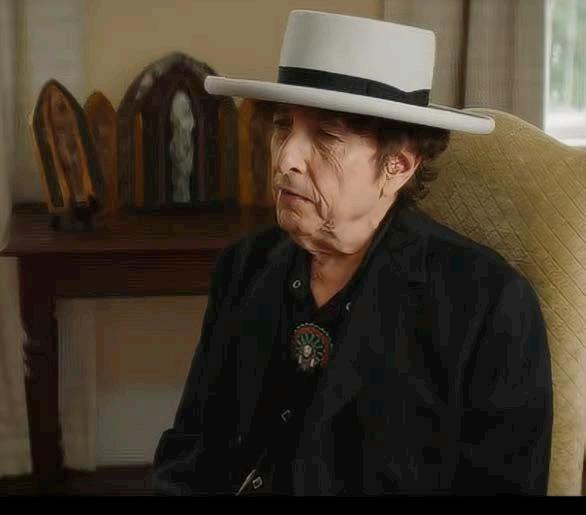
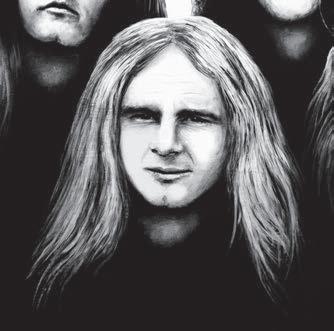





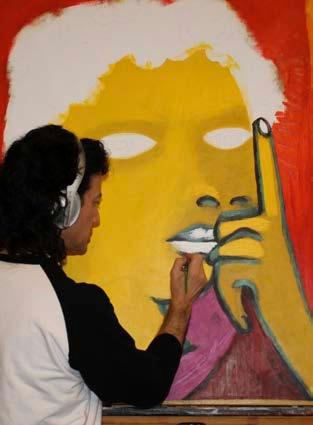







 by Doltyn Snedden
by Doltyn Snedden


















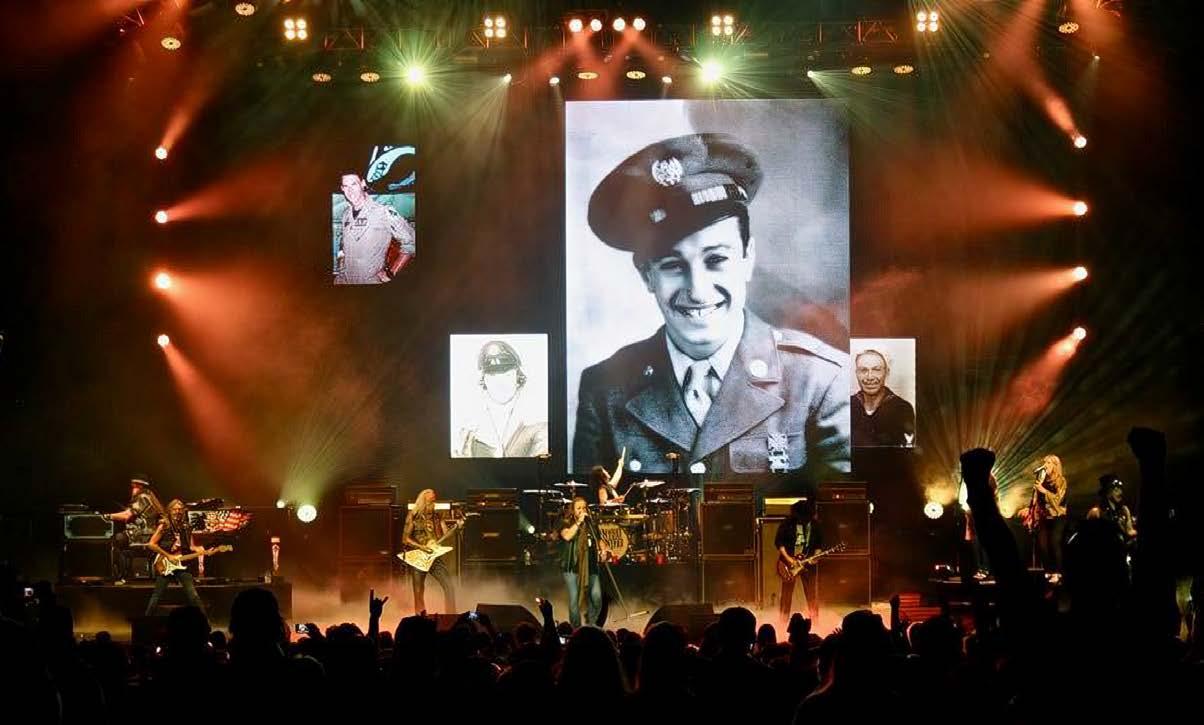















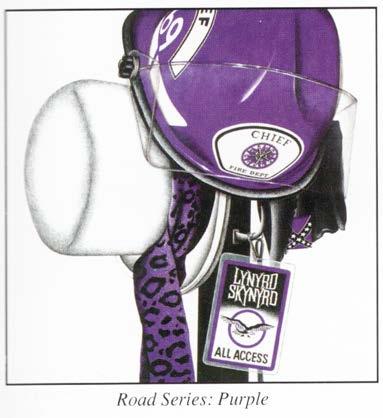





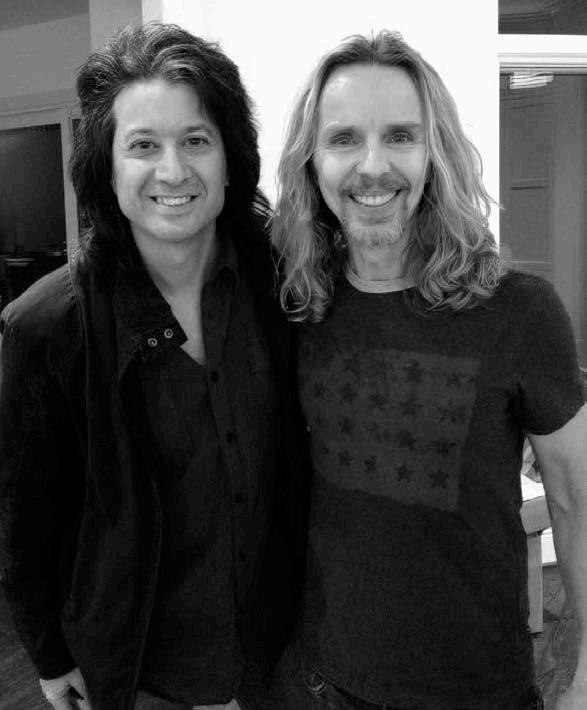



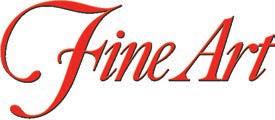

 Dale, Gary and Michael at Wentworth Gallery exhibition.
Dale, Gary and Michael at Wentworth Gallery exhibition.